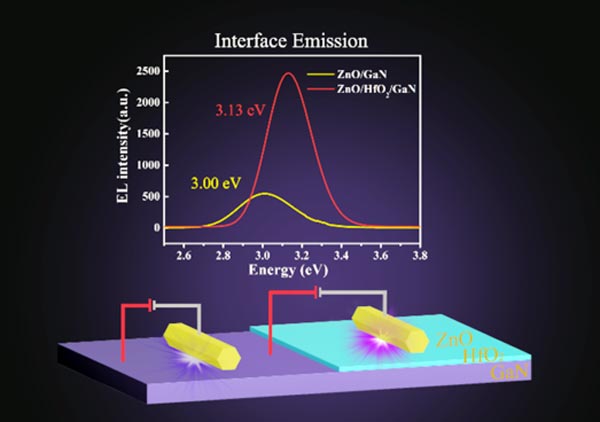Ultrathin electronic barrier layer to control interface luminescence

Improvement of the light emitting performance by presenting the nano-buffer layer."
Credit: OEA
In a new publication from Opto-Electronic Advances; DOI 10.29026/oea.2021.200064, Researchers led by Professor Xu Chunxiang, Southeast University, Nanjing, China discuss nano-buffer controlled electron tunneling to regulate heterojunctional interface emission.
Light emitting diodes (LEDs) are widely used in the field of lighting and display. Homojunction is the best choice when considering interface loss and carrier concentration matching. However, for some semiconductor materials, where it is difficult to obtain homojunction, energy level matching heterostructure is also a choice to build LEDs. Compared with GaN, ZnO has a band gap of 3.37ev, which is similar to GaN. However, its exciton binding energy is as high as 60 meV, which is much larger than room temperature thermal energy (26mev). Therefore its excitons can exist stably at room temperature, which is expected to realize room temperature exciton type light-emitting devices and low threshold laser devices. In 1997, Professor Tang Zikang obtained the optically pumped stimulated emission of ZnO thin films at room temperature; an article about this work published in Science [1] predicted the potential advantages of ZnO in the field of ultraviolet laser devices with “will UV lasers beat the blues?”.
Visible interface emission is inevitable in GaN / ZnO light-emitting diodes. Introducing an electron barrier is a common and effective method. In existing research, the appropriate electron barrier layer can effectively block the interface emission, but if it can be used by adjusting the interface emission, it will effectively improve the luminous efficiency of LED.
In view of the problems outlined above, the authors of this paper have systematically studied the regulation of HfO2 electron barrier layer on interface emission in GaN / ZnO structure. They discuss in detail the electric field change, energy band change and electron tunneling characteristics of the device structure after the introduction of ultra-thin HfO2 layer, so as to outline the influence of these on the electroluminescence characteristics of the device. The results show that when the thickness of HfO2 layer is 5.03 nm, the energy band of the device becomes steeper, and a large tunneling current will be generated at the interface between ZnO and HfO2 layer. The interface luminescence wavelength will move from 414 nm to 394 nm, and the overall luminescence intensity of the device will increase about twice.
This paper provides a research method for the interface emission control of semiconductor heterostructures, and a preparation method for obtaining efficient pure color heterostructure light-emitting diodes.
Article reference: Liu W, Li ZX, Shi ZL, Wang R, Zhu YZ et al. Nano-Buffer Controlled Electron Tunneling to Regulate Heterojunctional Interface Emission. Opto-Electron Adv (2021). doi: 10.29026/oea.2021.200064
Keywords: tunneling electron, light-emitting diode, heterojunctional interface, nano HfO2 buffer
Professor Xu Chunxiang, Southeast University, Nanjing, China has been engaged in the research of ZnO semiconductor physical devices for many years. His research group includes over 20 young teachers, postdoctorates and postgraduates. The team has undertaken many national key R & D projects, National Natural Science Foundation projects and other national, provincial and ministerial level scientific research projects. Nearly 100 papers have been published in Chinese and international journals with published articles having been cited more than 8000 times. Over 30 national invention patents from the department have been authorized.
This article is supported by the key projects of National Natural Science Foundation of China and the national key R & D program. The first authors of this paper are doctoral students Liu Wei and Li Zhuxin of the research group and young researcher Shi Zengliang
Opto-Electronic Advances (OEA) is a high-impact, open access, peer reviewed monthly SCI journal with an impact factor of 9.636 (Journals Citation Reports for IF 2020). Since its launch in March 2018, OEA has been indexed in SCI, EI, DOAJ, Scopus, CA and ICI databases over the time and expanded its Editorial Board to 33 members from 17 countries and regions (average h-index 46).
The journal is published by The Institute of Optics and Electronics, Chinese Academy of Sciences, aiming at providing a platform for researchers, academicians, professionals, practitioners, and students to impart and share knowledge in the form of high quality empirical and theoretical research papers covering the topics of optics, photonics and optoelectronics.
[1] Will UV Lasers Beat the Blues? Science, 1997, 276 (5314): 895. DOI: 10.1126/science.276.5314.895
More information: http://www.oejournal.org/oea
Editorial Board: http://www.oejournal.org/oea/editorialboard/list
All issues available in the online archive (http://www.oejournal.org/oea/archive).
Submissions to OEA may be made using ScholarOne (https://mc03.manuscriptcentral.com/oea).
ISSN: 2096-4579
CN: 51-1781/TN
Contact Us: oea@ioe.ac.cn
Twitter: @OptoElectronAdv (https://twitter.com/OptoElectronAdv?lang=en)
WeChat: OE_Journal
DOI: 10.29026/oea.2021.200064
Media Contact
Conor Lovett
Compuscript Ltd
c.lovett@cvia-journal.org
Office: 353-614-75205
All latest news from the category: Power and Electrical Engineering
This topic covers issues related to energy generation, conversion, transportation and consumption and how the industry is addressing the challenge of energy efficiency in general.
innovations-report provides in-depth and informative reports and articles on subjects ranging from wind energy, fuel cell technology, solar energy, geothermal energy, petroleum, gas, nuclear engineering, alternative energy and energy efficiency to fusion, hydrogen and superconductor technologies.
Newest articles

Largest magnetic anisotropy of a molecule measured at BESSY II
At the Berlin synchrotron radiation source BESSY II, the largest magnetic anisotropy of a single molecule ever measured experimentally has been determined. The larger this anisotropy is, the better a…

Breaking boundaries: Researchers isolate quantum coherence in classical light systems
LSU quantum researchers uncover hidden quantum behaviors within classical light, which could make quantum technologies robust. Understanding the boundary between classical and quantum physics has long been a central question…

MRI-first strategy for prostate cancer detection proves to be safe
Active monitoring is a sufficiently safe option when prostate MRI findings are negative. There are several strategies for the early detection of prostate cancer. The first step is often a…



